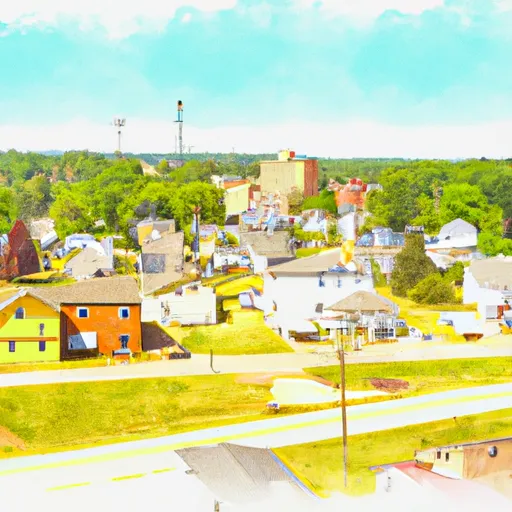-
 Snoflo Premium
Snoflo Premium
Get unlimited access to all our content
With no Ad interruptions! - Start Your Free Trial Login with existing account
Shepherd
Eden Index
Climate
7.1
•
Recreation
2.8
•
Community
2.7
•
Safeguard
4.5/10

Shepherd, Michigan is a small town located in Isabella County in the central part of the state. The climate in Shepherd is typical of the Midwest, with warm summers and cold winters. Summers are often mild to warm, with average temperatures ranging from the 70s to the low 80s Fahrenheit. Winters, on the other hand, can be quite cold, with average temperatures in the 20s and occasional snowfall.
Hydrology constituents in Shepherd are mainly influenced by the Chippewa River, which flows through the town. The river provides opportunities for fishing, canoeing, and kayaking. Additionally, Shepherd is home to several small lakes and ponds that offer further recreational activities such as swimming and boating.
Outdoor recreation opportunities in Shepherd are abundant. The town boasts numerous parks and nature reserves, providing opportunities for hiking, biking, and picnicking. The Chippewa River State Forest, located nearby, offers additional outdoor activities such as camping, hunting, and wildlife observation. Shepherd also hosts various community events and festivals throughout the year, including a summer concert series and a fall harvest festival, providing residents and visitors with ample opportunities to enjoy the outdoors.
What is the Eden Index?
The Snoflo Eden Index serves as a comprehensive rating system for regions, evaluating their desirability through a holistic assessment of climate health, outdoor recreation opportunities, and natural disaster risk, acknowledging the profound impact of these factors on livability and well-being.
Climate Health Indicator (CHI): 7.1
Shepherd receives approximately
821mm of rain per year,
with humidity levels near 81%
and air temperatures averaging around
9°C.
Shepherd has a plant hardyness factor of
5, meaning
plants and agriculture in this region thrive during a short period during spring and early summer. Most
plants will die off during the colder winter months.
By considering the ideal temperature range, reliable water supplies, clean air, and stable seasonal rain or snowpacks, the Climate Health Indicator (CHI) underscores the significance of a healthy climate as the foundation for quality living.
A healthy climate is paramount for ensuring a high quality of life and livability in a region, fostering both physical well-being and environmental harmony. This can be characterized by ideal temperatures, reliable access to water supplies, clean air, and consistent seasonal rain or snowpacks.
Weather Forecast
Streamflow Conditions
Saginaw
Area Rivers
Saginaw
Snowpack Depths
Saginaw
Reservoir Storage Capacity
Saginaw
Groundwater Levels
Recreational Opportunity Index (ROI): 2.8
The Recreational Opportunity Index (ROI) recognizes the value of outdoor recreational options, such as parks, hiking trails, camping sites, and fishing spots, while acknowledging that climate plays a pivotal role in ensuring the comfort and consistency of these experiences.
Access to outdoor recreational opportunities, encompassing activities such as parks, hiking, camping, and fishing, is crucial for overall well-being, and the climate plays a pivotal role in enabling and enhancing these experiences, ensuring that individuals can engage in nature-based activities comfortably and consistently.
Camping Areas
| Campground | Campsites | Reservations | Toilets | Showers | Elevation |
|---|---|---|---|---|---|
| Camp Petosega | None | 673 ft | |||
| Maple Bay - State Forest | 38 | 600 ft | |||
| Marble Lake County Park | None | 995 ft | |||
| Maple River Campground | 60 | 677 ft | |||
| Herrick Rec Area | 70 | 806 ft | |||
| Cecil Lakeview City Park | None | 579 ft | |||
| Eaton County Fairgrounds | 340 | 880 ft | |||
| Burt Lake State Park | 300 | 610 ft | |||
| Straits State Park | 275 | 672 ft | |||
| Swains Lake | None | 994 ft |
Nearby Ski Areas
Catastrophe Safeguard Index (CSI):
The Catastrophe Safeguard Index (CSI) recognizes that natural disaster risk, encompassing floods, fires, hurricanes, and tornadoes, can drastically affect safety and the overall appeal of an area.
The level of natural disaster risk in a region significantly affects safety and the overall livability, with climate change amplifying these risks by potentially increasing the frequency and intensity of events like floods, fires, hurricanes, and tornadoes, thereby posing substantial challenges to community resilience and well-being.
Community Resilience Indicator (CRI): 2.7
The Community Resilience Indicator (CRI) recognizes that education, healthcare, and socioeconomics are crucial to the well-being of a region. The CRI acknowledges the profound impact of these elements on residents' overall quality of life. By evaluating educational resources, healthcare accessibility, and economic inclusivity, the index captures the essential aspects that contribute to a thriving community, fostering resident satisfaction, equity, and social cohesion.

